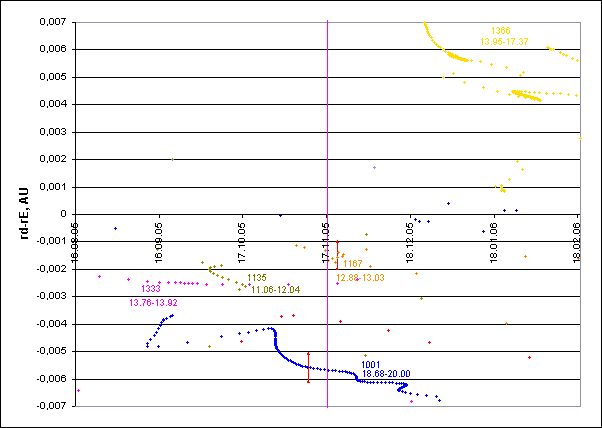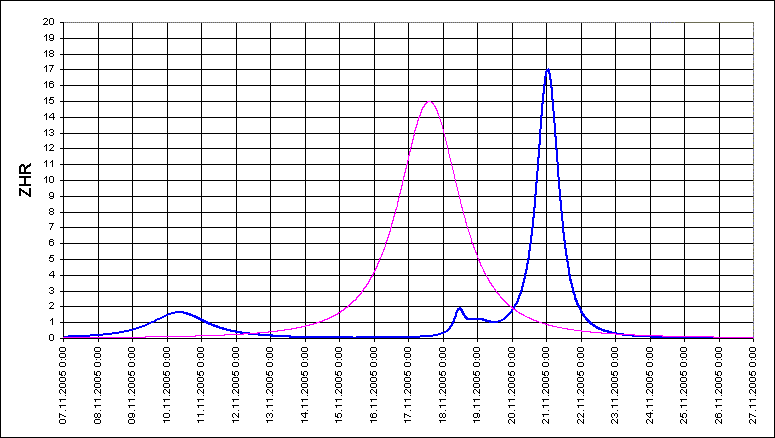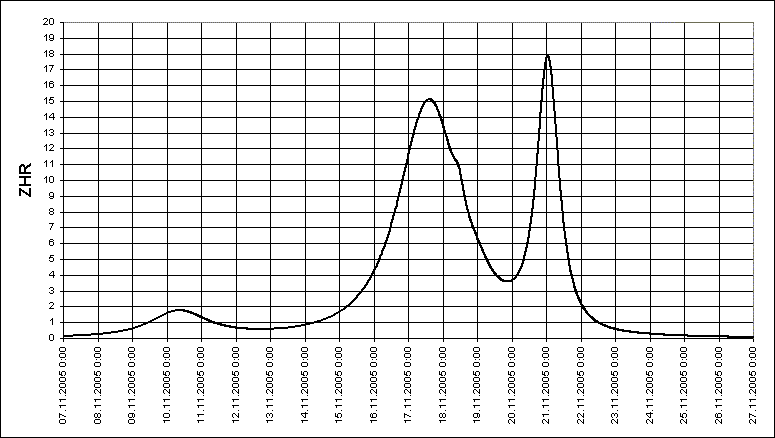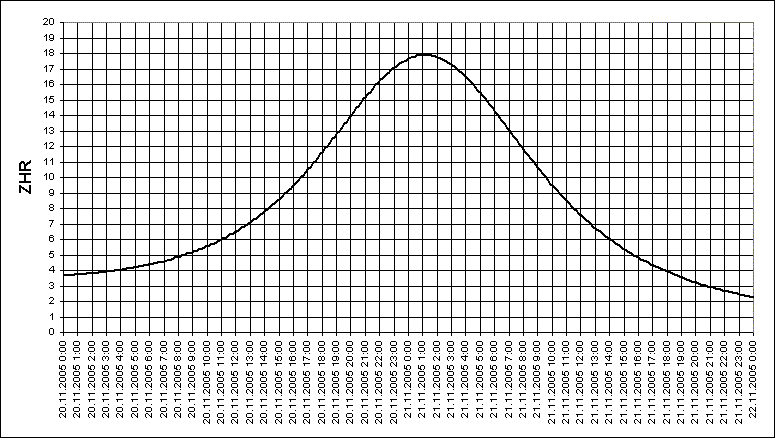Leonids 2005 - activity prediction
Introduction
Leonids is a meteor shower known for its variable activity. The years around parent comet 55P Tempel-Tuttle returns gave considerable activity enhancements, sometimes up to stormy levels. The latest perihelion of 55P was in 1998 and now it is moving to the outer areas of Solar system - its aphelion lies behind the orbit of Saturn. Significant enhancements in Leonid activity were recorded during the period 1994-2003. In 1999, 2001 and 2002 the shower gave several storms, when ZHR reached 3000-4000 (ZHR - zenithal hourly rate - the average number of shower meteors an observer can see during one hour when its radiant is directly overhead and stars to 6.5 mag. are visible). In 2003 and 2004 activity was slightly above the background level with ZHRs of 60 and 28 respectively (background activity is peculiar to Leonids in its "quiet" years, it usually reaches ZHR=10-20).
All main peaks of Leonid activity are tracked very well with the use of meteor particles evolution modelling. Particles ejected by the comet form lengthy trails. One of the reasons is radiation pressure force, which acts parallel with gravitational forces. Gravitational force is dependent on a particle mass, i.e. it is proportional to the third power of particle radius. The outcrying radiation pressuse is defined by the second power of particle radius. So far the influence of radiation pressure is the more the less is size of a particle. Its action is equivalent to the diminishing of gravitational constant G. So it increases the orbital period of particles, and the tinier a particle is, the more it is continuously retarded from larger particles after their ejection be the comet. This process therefore leads to the formation of lengthy comet trails.
Meteor modelling is done through computation of orbital evolution of particles ejected by the comet with different velocities in directions tangential to the comet trajectory at the moment of perihelion. In the reality, of course, particles are ejected not only in the point of perihelion, but also during several months around it. However, comets are in perihelion part of their orbits during quite a little time comparing to their overall orbital period and main perturbations happen around their aphelions, so when comets are closer to the Sun newly ejected particles are moving very close to them in a compact dust cloud. This is the reason we can take that cloud as completely ejected in the point of perihelion, it doesn't virtualy influence to the results of computations.
Speaking of directions in which perticles are ejected we can say that, again, in the reality they are ejected far not only in tangential directions, but in all possible ones. However, ejection velocities (from 0 to 100 m/s, and the overwhelming majority of real ejections - from 0 to 20 m/s) are negligibly small comparing to the own comet velocity (from 30 to 40 km/s) near the Earth's orbit), ejected particles have only slightly changed orbits and don't "fly away in all directions". Radial part of ejection velocity defines only thickness of a trail, which usually reaches several hundreds thousands kilometers. The shape of the trail is defined by tangential part of ejection velocity.
And the last. Non-gravitational forces are often not taken into consideration in meteor calculations, as is in our case. However, some of them, say, radiation pressure, can be considered indirectly. As far as this kind of force works as diminishing of gravitational constant G, this is equivalent to increase of ejection velocity which could be easily accounted in the model. So this non-gravitational force, as many others doesn't change configuration of trails, but leads to shifting of particles with different masses along them.
As spoken previously, Leonid trails modelling allowed to prepare very good predictions of shower activity around the latest comet perihelion, real maximums differed from predicted ones mostly no more than on 10-15 minutes - not very much considering that computations are made for several hundreds years of particles movement. Also succesful post-predictions were done for Leonid outbursts in the past, for example, for famous storm in 1966. More serious problem is prediction of outburst intensity - how strong the maximum could be. For such predictions special empirical models were elaborated (the single way in this case) but as before for their improvment new observations are very necessary.
The results the Author obtained for the Leonids 2005 using the modelling of perticles ejected by the comet 55P Tempel-Tuttle are presented below. Main characteristics of computations are also described.
Computation characteristics
I wish to introduce the first results of Leonids meteor stream simulation aimed to the prediction of shower activity in 2005. The simulation was made for the trails of latest 30 revolutions, i.e, from the 1001 trail and partially for the trails of 31-33, i.e. 901, 935 and 967 trails. The Author used the program by S. Shanov and S. Dubrovsky to calculate orbital elements of ejected meteor particles. To estimate expected ZHRs for different encounters the model by E. Lyytinen and T. van Flandern given in their paper "Predicting the strength of Leonid outbursts" was used with some Author's alterations made in order to adopt the model for ejection velocity (v) instead of da0 (difference in a-semimajor axis) as well as to correct fn function to consider factual Leonids activity during recent storms and outbursts. The computation considered only gravitational forces, however, the results are on the whole in good accordance with these of other researchers. The prediction includes all encounters found within interval +/-0.007 a.u. The following parts of trails were computed: the first 5 rev. trails for ejection velocities [-50;100] m/s, 6-10 rev. trails - [-30;50] m/s, 10-20 rev. trails - [-20;30], older than 20 rev. trails - [-10;20] m/s.
Results
For 2005 several encounters with old trails are found. They are given in the Table 1.
Table 1 Non-zero encounters between Earth and Leonid trails in 2005
Distribution of of particles of different Leonid trails is given on Fig. 1.
Leonids is a meteor shower known for its variable activity. The years around parent comet 55P Tempel-Tuttle returns gave considerable activity enhancements, sometimes up to stormy levels. The latest perihelion of 55P was in 1998 and now it is moving to the outer areas of Solar system - its aphelion lies behind the orbit of Saturn. Significant enhancements in Leonid activity were recorded during the period 1994-2003. In 1999, 2001 and 2002 the shower gave several storms, when ZHR reached 3000-4000 (ZHR - zenithal hourly rate - the average number of shower meteors an observer can see during one hour when its radiant is directly overhead and stars to 6.5 mag. are visible). In 2003 and 2004 activity was slightly above the background level with ZHRs of 60 and 28 respectively (background activity is peculiar to Leonids in its "quiet" years, it usually reaches ZHR=10-20).
All main peaks of Leonid activity are tracked very well with the use of meteor particles evolution modelling. Particles ejected by the comet form lengthy trails. One of the reasons is radiation pressure force, which acts parallel with gravitational forces. Gravitational force is dependent on a particle mass, i.e. it is proportional to the third power of particle radius. The outcrying radiation pressuse is defined by the second power of particle radius. So far the influence of radiation pressure is the more the less is size of a particle. Its action is equivalent to the diminishing of gravitational constant G. So it increases the orbital period of particles, and the tinier a particle is, the more it is continuously retarded from larger particles after their ejection be the comet. This process therefore leads to the formation of lengthy comet trails.
Meteor modelling is done through computation of orbital evolution of particles ejected by the comet with different velocities in directions tangential to the comet trajectory at the moment of perihelion. In the reality, of course, particles are ejected not only in the point of perihelion, but also during several months around it. However, comets are in perihelion part of their orbits during quite a little time comparing to their overall orbital period and main perturbations happen around their aphelions, so when comets are closer to the Sun newly ejected particles are moving very close to them in a compact dust cloud. This is the reason we can take that cloud as completely ejected in the point of perihelion, it doesn't virtualy influence to the results of computations.
Speaking of directions in which perticles are ejected we can say that, again, in the reality they are ejected far not only in tangential directions, but in all possible ones. However, ejection velocities (from 0 to 100 m/s, and the overwhelming majority of real ejections - from 0 to 20 m/s) are negligibly small comparing to the own comet velocity (from 30 to 40 km/s) near the Earth's orbit), ejected particles have only slightly changed orbits and don't "fly away in all directions". Radial part of ejection velocity defines only thickness of a trail, which usually reaches several hundreds thousands kilometers. The shape of the trail is defined by tangential part of ejection velocity.
And the last. Non-gravitational forces are often not taken into consideration in meteor calculations, as is in our case. However, some of them, say, radiation pressure, can be considered indirectly. As far as this kind of force works as diminishing of gravitational constant G, this is equivalent to increase of ejection velocity which could be easily accounted in the model. So this non-gravitational force, as many others doesn't change configuration of trails, but leads to shifting of particles with different masses along them.
As spoken previously, Leonid trails modelling allowed to prepare very good predictions of shower activity around the latest comet perihelion, real maximums differed from predicted ones mostly no more than on 10-15 minutes - not very much considering that computations are made for several hundreds years of particles movement. Also succesful post-predictions were done for Leonid outbursts in the past, for example, for famous storm in 1966. More serious problem is prediction of outburst intensity - how strong the maximum could be. For such predictions special empirical models were elaborated (the single way in this case) but as before for their improvment new observations are very necessary.
The results the Author obtained for the Leonids 2005 using the modelling of perticles ejected by the comet 55P Tempel-Tuttle are presented below. Main characteristics of computations are also described.
Computation characteristics
I wish to introduce the first results of Leonids meteor stream simulation aimed to the prediction of shower activity in 2005. The simulation was made for the trails of latest 30 revolutions, i.e, from the 1001 trail and partially for the trails of 31-33, i.e. 901, 935 and 967 trails. The Author used the program by S. Shanov and S. Dubrovsky to calculate orbital elements of ejected meteor particles. To estimate expected ZHRs for different encounters the model by E. Lyytinen and T. van Flandern given in their paper "Predicting the strength of Leonid outbursts" was used with some Author's alterations made in order to adopt the model for ejection velocity (v) instead of da0 (difference in a-semimajor axis) as well as to correct fn function to consider factual Leonids activity during recent storms and outbursts. The computation considered only gravitational forces, however, the results are on the whole in good accordance with these of other researchers. The prediction includes all encounters found within interval +/-0.007 a.u. The following parts of trails were computed: the first 5 rev. trails for ejection velocities [-50;100] m/s, 6-10 rev. trails - [-30;50] m/s, 10-20 rev. trails - [-20;30], older than 20 rev. trails - [-10;20] m/s.
Results
For 2005 several encounters with old trails are found. They are given in the Table 1.
Table 1 Non-zero encounters between Earth and Leonid trails in 2005
trail Year rd-re ej. Vel. fM(fMD) sol.long max. Time ZHR ex. rev. а.е. м/с град. UT 28 1001 -0,00558 19,37 -0,174 227,965 10.11.05 8:30 2 18 1400 -0,00011 10,01 -0,002 236,145 18.11.05 11:29 1 20 1333 -0,00253 13,77 -0,012 236,678 19.11.05 0:09 1 25 1167 -0,00119 12,91 -0,005 238,639 20.11.05 22:47 1 25 1167 -0,00138 12,95 0,050 238,700 21.11.05 0:14 6 25 1167 -0,00157 12,98 -0,089 238,762 21.11.05 1:43 9 25 1167 -0,00177 13,01 0,021 238,832 21.11.05 3:22 2where trail is the number of revolutions of given trail; year - the year of trail formation; rd-re - the distance between the Earth's orbit and trail particles orbit (positive value means the descending node of trail is outside the Earth's orbit, negative - the node is inside it); ej. Vel - velocity particles ejection on the given trail part (positive values means the particles were ejected against the comet movement, negavive - particles the ejected along the comet movement); fM(fNP) - the characteristic of longitudinal density of a trail, it is derived from the time interval between minimal distance to the Earth's orbit passages of particles with different ejection velocities; sol. long - solar longitude corresponding the maximum; ZHR ex. ZHR expected to be produced by the trail.
Distribution of of particles of different Leonid trails is given on Fig. 1.

Рис. 1. Space-temporal projection of Leonid trails parts onto their nodal passages.
The following two figures depict: separate graphs of expected activity from trails and background (Fig. 2) and overall Leonid activity profile during the period of their action (Fig. 3).

Рис. 2. The assumed profile of backgroung (the red line) and additional activity from trails (the blue line).

Рис. 3. The assumed profile of overall Leonid activity (from trails and background).
In these graphs expected trails activity is based on the Author's calculations, and background activity profile is typical with max. background ZHR=15. The time of background maximum, according to the IMO, is 14:30 UT on 17 November.
So far, there are no significant outbutsts expected for 2005. However, the encounter with several parts of separated cloud of 1167 trail seems to be interesting. This cloud retained quite regular structure, although twisted several times, which is the reason of multiple encounters. Overall profile of expected trail activity is given on Fig. 4.
So far, there are no significant outbutsts expected for 2005. However, the encounter with several parts of separated cloud of 1167 trail seems to be interesting. This cloud retained quite regular structure, although twisted several times, which is the reason of multiple encounters. Overall profile of expected trail activity is given on Fig. 4.

Рис. 4. The assumed profile of Leonid activity around the encounter with 1167 trail.
So far, the formal value of max. ZHR from all the encounters with 25 rev. trail is about 18. It is to be reached at 1:10 UT Novemver 21. I would like to emphasise this considerable shift of trail maximum time from Leonid background maximum on 17-18 November. The fig. 3 shows that on 20 November, in the gap between background in the 1167 trails maximums activity can drop to ZHRs of 3-4. It means that during the time of suggested 1167 trail activity, Leonid background should be mostly over and won't disturb to watch on any enhancements.
The fig. 4 shows that expected peak should be very long - activity above the half of the maximum could last up to 20 hours. The brightness of 1167 trail meteors is expected to be average.
Leonid activity observation in 2005 will heavily suffer from the waning gibbous Moon high in the sky. This situation coupled with not very bright meteors means significant worsening observing conditions. Nevertheless, watching for possible enhancenents in shower activity, especially on 20-21 November seems to be very important because of getting additional information on what we could expect from very old trails. This should increase accuracy of activity predictions in the future.
Because of old age of 1167 trail we have remember that certainty of this prediction is lower than of, say, Leonid predictions for 1999-2004. And the mistake can be both positive (ZHR prediction is quite conservative, and if the encounter takes place, real ZHR can easily be 2-3 times higher than predicted) and negative (absense of activity). The reason of possible failure could be model imperfection as well as faulty orbital elements of 55P, computed for those ancient years.
Also it should be emphasized the encounter with 1001 trail on 8:30 UT 10 November. It won't be close, so ZHR could be only about 2-3. However, background activity is still absent at this time. Also, the Moon these days will set soon after the midnight. So far, Leonid amateurs can try to watch some of its meteors on the moonless sky, all the more 1001 trail meteors are expected to be mostly quite faint.
Finally it should be noted that background activity in 2005 can be lower than average because the trails mass seems to considerably shift inside the Earth's orbit.
Conclusions
No significant Leonid outbursts are expected in 2005. Nevertheless, meteor modelling shows that besides background maximum on 17 November, a peak from 1167 trail is possible at 1:10 UT 21 November with duration of up to 20 hours. ZHR expected for this peak is 18, meteor brightness should be average. In 2005 shower activity observations will suffer from the moonlight, however they are very important for estimation of activity from very old trails. The favorable fact is that the trail maximum is remoted from background one, so it will be easier to watch for any enhancements around the predicted time. Background activity itself is expected to be lower than average. Also, the first signs of Leonid activity can occur as soon as on around 8:30 UT 10 November, when the Earth will encounter with 1001 trail. ZHRex is only 2, however, this days the Moon will set soon after the midnight so observers have good chances to see some Leonid meteors on the moonless sky. The major part of 1001 trail meteors is expected to be quite faint.
Also, here you can see the results gotten by Jeremie Vaubaillon.
References
1. "Comet's dust 2.0" program by S. Shanov and S. Dubrovsky. [Used for orbital computations.]
2. NK 722 http://www.oaa.gr.jp/~7Eoaacs/nk/nk722.htm [Orbital elements of 55P Tempel-Tuttle].
3. Lyytinen E, van Flandern T. "Predicting the strength of Leonid outbursts", 2000, Icarus, P. 158-160.
The fig. 4 shows that expected peak should be very long - activity above the half of the maximum could last up to 20 hours. The brightness of 1167 trail meteors is expected to be average.
Leonid activity observation in 2005 will heavily suffer from the waning gibbous Moon high in the sky. This situation coupled with not very bright meteors means significant worsening observing conditions. Nevertheless, watching for possible enhancenents in shower activity, especially on 20-21 November seems to be very important because of getting additional information on what we could expect from very old trails. This should increase accuracy of activity predictions in the future.
Because of old age of 1167 trail we have remember that certainty of this prediction is lower than of, say, Leonid predictions for 1999-2004. And the mistake can be both positive (ZHR prediction is quite conservative, and if the encounter takes place, real ZHR can easily be 2-3 times higher than predicted) and negative (absense of activity). The reason of possible failure could be model imperfection as well as faulty orbital elements of 55P, computed for those ancient years.
Also it should be emphasized the encounter with 1001 trail on 8:30 UT 10 November. It won't be close, so ZHR could be only about 2-3. However, background activity is still absent at this time. Also, the Moon these days will set soon after the midnight. So far, Leonid amateurs can try to watch some of its meteors on the moonless sky, all the more 1001 trail meteors are expected to be mostly quite faint.
Finally it should be noted that background activity in 2005 can be lower than average because the trails mass seems to considerably shift inside the Earth's orbit.
Conclusions
No significant Leonid outbursts are expected in 2005. Nevertheless, meteor modelling shows that besides background maximum on 17 November, a peak from 1167 trail is possible at 1:10 UT 21 November with duration of up to 20 hours. ZHR expected for this peak is 18, meteor brightness should be average. In 2005 shower activity observations will suffer from the moonlight, however they are very important for estimation of activity from very old trails. The favorable fact is that the trail maximum is remoted from background one, so it will be easier to watch for any enhancements around the predicted time. Background activity itself is expected to be lower than average. Also, the first signs of Leonid activity can occur as soon as on around 8:30 UT 10 November, when the Earth will encounter with 1001 trail. ZHRex is only 2, however, this days the Moon will set soon after the midnight so observers have good chances to see some Leonid meteors on the moonless sky. The major part of 1001 trail meteors is expected to be quite faint.
Also, here you can see the results gotten by Jeremie Vaubaillon.
References
1. "Comet's dust 2.0" program by S. Shanov and S. Dubrovsky. [Used for orbital computations.]
2. NK 722 http://www.oaa.gr.jp/~7Eoaacs/nk/nk722.htm [Orbital elements of 55P Tempel-Tuttle].
3. Lyytinen E, van Flandern T. "Predicting the strength of Leonid outbursts", 2000, Icarus, P. 158-160.